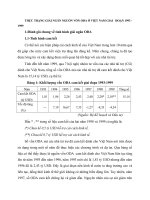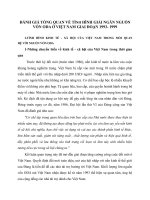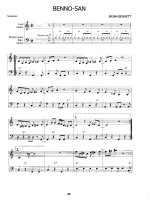Bsi bs au 209 7 1993 (1999)
Bạn đang xem bản rút gọn của tài liệu. Xem và tải ngay bản đầy đủ của tài liệu tại đây (256.59 KB, 10 trang )
BRITISH STANDARD
Vehicle security —
Part 7: Specification for locking systems
for goods vehicle driver’s
compartments
BS AU
209-7:1 993
BS AU 209-7:1 993
Committees responsible for this
British Standard
The preparation of this British Standard was entrusted by the Automobile
Standards Policy Committee (AUE/- ) to Technical Committee AUE/1 7, upon
which the following bodies were represented:
Association of Car Fleet Operators
Automobile Association
British Security Industry Association
Consumers’ Association
Consumer Policy Committee of BSI
Department of Trade and Industry
Department of Transport
Freight Transport Association
Home Office
Institute for Consumer Ergonomics Ltd.
Master Locksmiths’ Association
Metropolitan Police
Motor Industry Research Association
Road Haulage Association Ltd.
Royal Automobile Club
Society of Motor Manufacturers and Traders Ltd.
This British Standard, having
been prepared under the
direction of the Automobile
Standards Policy Committee, was
published under the authority of
the Standards Board and comes
into effect on
1 5 July 1 993
© BSI 08- 1 999
The following BSI references
relate to the work on this
standard:
Committee reference AUE/1 7
Draft for comment 91 /7691 1 DC
ISBN 0 5 80 21 781 7
Amendments issued since publication
Amd. No.
Date
Comments
BS AU 209-7:1 993
Contents
Page
Committees responsible
Foreword
ii
1
Scope
1
2
References
1
3
Definitions
1
4
Locks operated by mechanical keys
1
5
Exterior release controls
2
6
Functional requirements
3
7
Test conditions
3
Annex A (normative) Lock and key wear test
4
Annex B (normative) Electrically powered system test
4
List of references
© BSI 08- 1 999
Inside front cover
Inside back cover
i
BS AU 209-7:1 993
Foreword
This Part of BS AU 209 has been prepared under the direction of the Automobile
Standards Policy Committee, at the request of the Department of Transport and
with the support of the Home Office and organizations connected with law
enforcement, the motor vehicle construction industry and vehicle user
organizations.
Hitherto, no standard has existed for the United Kingdom that defines the
performance and use of equipment intended to prevent or deter unauthorized
entry into or removal of a motor vehicle.
This standard is not a substitute for anti- burst latch test requirements of vehicle
doors, nor for protective devices used on the steering system, transmission or gear
lever.
It is considered essential that goods vehicles should be equipped with a dead
locking facility which requires minimum effort from the driver to achieve a
satisfactory level of vehicle security.
It is recognized that this standard covers a relatively new area, not previously
standardized and that it may be necessary to amend the requirements resulting
from initial experience of its use.
Other Parts of BS AU 209 are:
— Part 1 a: Specification for locking systems for passenger cars and car derived
vehicles;
— Part 2: Specification for security systems against theft of in-car equipment for
entertainment and communication purposes;
— Part 3: Specification for security marking of glazing for passenger cars and
car derived vehicles;
— Part 5a: Specification for central power locking systems for passenger cars
and car derived vehicles;
— Part 6: Specification for dead locking systems for passenger cars and car
derived vehicles;
— Part 8: Specification for locking systems for the load carrying compartment
— Part 9: Specification for security of ancillary equipment on CVs
1)
1)
;
;
— Part 1 0: Specification for immobilizers.
A British Standard does not purport to include all the necessary provisions of a
contract. Users of British Standards are responsible for their correct application.
Compliance with a British Standard does not of itself confer immunity
from legal obligations.
Summary of pages
This document comprises a front cover, an inside front cover, pages i and ii,
pages 1 to 4, an inside back cover and a back cover.
This standard has been updated (see copyright date) and may have had
amendments incorporated. This will be indicated in the amendment table on the
inside front cover.
1)
ii
In preparation.
© BSI 08- 1 999
BS AU 209-7:1 993
1 Scope
This Part of BS AU 209 specifies requirements for
3.4
closure
the performance of locking systems fitted to all
a physical barrier which fits in an aperture and is
closures through which access may be gained to the
designed to move to enable, or prevent, access
driver’s compartment of goods vehicles. Goods
through that aperture
carrying compartments which are not accessible
3.5
from the driver’s compartment, are the subj ect of
latch
Part 8 of this British Standard.
a mechanism employed to retain a door or
This Part of BS AU 209 does not apply to category
compartment cover in a closed condition with
N. 1 (gross vehicle mass of up to 3. 5 t) vehicles that
provision for controlled release (or operation)
have been derived from passenger cars.
2 References
2.1 Normative reference
This Part of BS AU 209 incorporates, by reference,
provisions from a specific edition of another
publication. This normative reference is cited at the
appropriate point in the text and the publication is
3.6
freewheel
the ability of a button or handle to move without
releasing the latch
3.7
central power locking system
a facility that provides for the locking/unlocking by
given on the inside back cover. Subsequent
a single action, of all closures to the driver’s
amendments to, or revisions of, this publication
compartment
apply to this Part of BS AU 209 only when
3.8
incorporated in it by updating or revision.
2.2 Informative references
normal locking
a facility that provides locking of the driver’s
This Part of BS AU 209 refers to other publications
compartment doors such that their exterior release
that provide information or guidance. Editions of
controls are rendered inoperable
these publications current at the time of issue of this
standard are listed on the inside back cover, but
reference should be made to the latest editions.
3.9
dead locking
a facility which prevents the unlocking of the
3 Definitions
For the purposes of this Part of BS AU 209 the
following definitions apply.
3.1
goods vehicle
vehicle used for the carriage of goods and having a
gross vehicle mass, as defined in the European
Community Directive 70/1 56/EEC, of:
a) up to a maximum of 3. 5 t: category N. 1 ;
b) from 3. 5 t to a maximum of 1 2 t: category N. 2;
c) maximum in excess of 1 2 t: category N. 3.
3.2
closure other than by operation of the key
3.1 0
internal locking/unlocking control
any device located within the vehicle that controls
the locking mechanism of the latch
4 Locks operated by mechanical keys
4.1 A lock intended to be unlocked from outside the
vehicle, using its own specifically coded key, shall
conform to Annex A.
4.2 The lock and its key shall, after being tested in
accordance with A.2 , remain an effective specific
combination.
lock
4.3 After completion of the test in A.2 , further
a device that prevents the release of a latch and that
manipulation of a minimum difference key for 1 min
can only be activated by the use of:
shall not unlock the assembly.
a) a specifically coded key; and/or
b) a linkage between the latch mechanisms and
controls situated within the vehicle.
4.4 Keys shall not be permanently marked with
their coded identification except on the tags
designed to be removed by the user. Key code
information shall not appear elsewhere on the
3.3
vehicle or its equipment, including handbooks, or on
key
the lock.
a device, specifically coded to match a specific lock
© BSI 08- 1 999
1
BS AU 209-7:1 993
The key locking system shall comprise not less
than 1 000 different key combinations for any one
series of key combinations.
4.6 Locks incorporating tumblers shall have no
more than two identical tumblers operating in the
same direction, positioned adjacent to each other.
There shall be not more than 50 % of identical
tumblers in a lock.
4.7 It shall not be possible to release the latch or
enable it to be released by any of the following
means.
a) By rotating the lock cylinder within its housing
or the housing within its mounting on the vehicle
in accordance with the following torque test
procedure, using a tool, normally in the form of a
key blank, and manufactured from high strength
steel, hardened and tempered to a hardness on
the Rockwell scale of HRC 48 to HRC 56, for the
length of engagement of it into the lock plus a
further 10 mm proud of the lock face.
1) The tool shall be of such a size that it can
transmit the maximum possible torque to the
lock cylinder and yet it can be inserted into the
lock with an axial force not exceeding 600 N.
2) Insert the tool into the lock and apply an
axial load of 600 N ± 10 N while applying an
increasing torque until one of the following
occurs:
i) the tool fails within 10 mm of the lock
face; or
ii) the torque applied exceeds 100 N·m; or
iii) it is not possible to achieve a torque
of 100 N·m for other mechanical reasons.
3) Remove any easily removable parts and if
the resulting key opening has been enlarged
then item 2) shall be repeated once using a
larger tool which conforms to item 1).
b) By displacing the lock cylinder from its housing
or the housing from its mounting on the vehicle or
by distorting the body panel, using the following
axial test procedure.
1)
Insert the largest size of high
quality steel self-tapping screw, conforming to
ISO 2702:1974, that can be screwed into the
lock without breaking the screw or exceeding a
torque of 100 N·m. Apply an increasing force
along the axis of the screw in the tensile mode
until one of the following occurs:
i) the screw fails; or
ii) the load applied exceeds 1 200 N; or
iii) it is not possible to achieve a load
of 1 200 N for other mechanical reasons.
4.5
Tens ile.
2
2)
Apply an increasing force
along the axis of the lock in the compressive
mode until one of the following occurs:
i) the load applied exceeds 1 200 N; or
ii) it is not possible to achieve a load
of 1 200 N for other mechanical reasons.
c) By displacing the lock cylinder from its housing
or the housing from its mounting on the vehicle or
by distorting the body panel in accordance with
the following bending moment test procedure,
using a tool, normally in the form of a key blank,
and manufactured from high strength steel,
hardened and tempered to a hardness on the
Rockwell scale of HRC 48 to HRC 56, for the
length of engagement of it into the lock plus a
further 10 mm proud of the lock face.
1) The tool shall be of such a size that it can
transmit the maximum possible bending
moment to the lock cylinder and yet it can be
inserted into the lock with an axial force not
exceeding 600 N.
2) Insert the tool into the lock and apply an
axial load of 600 N ± 10 N while applying a
bending moment up to a maximum of 60 N·m
but not exceeding the yield point of the tool,
alternatively upwards and downwards
for 20 cycles. Each cycle shall consist of the
maximum bending moment applied upwards
for a least 0.5 s followed by the maximum
bending moment downwards applied for at
least 0.5 s. Repeat the procedure using
opposite directions in the horizontal plane
using a new tool, lock and closure.
Com p ress iv e.
NOTE At the discretion of the test authority a third
plane may be chosen if it is judged to represent the worst
case situation and a new tool, lock and closure used.
3) Remove any easily removable parts and if
the resulting key opening has been enlarged
then item 2) shall be repeated using a larger
tool which conforms to item 1).
Where the mechanism is fractured or damaged as a
result of verifying conformance to a), b) or c) the
mechanism shall be deemed to satisfy the
requirements provided that entry into the vehicle
cannot be subsequently achieved by releasing the
latch via any resulting aperture using a simple tool
or by applying the test procedure in 7.4 .
5 Exterior release controls
Exterior push buttons or handles shall either
freewheel when in the locked state, or be so
constructed that, when in the locked state and
sufficient force is applied so as to produce the full
operating movement of the release button or handle,
such movement shall not effect entry into the
vehicle.
© BSI 08-1999
BS AU 209-7:1 993
6 Functional requirements
6.1 All closures to the driver’s compartment shall be
either:
d) it shall not be possible for a single power
malfunction to cause deadlocking of all the
closures. Conformity shall be checked by
calculation, based on information which shall be
a) secured by latches which are capable of being
provided by the manufacturer.
locked from inside and outside the driver’s
compartment; or
b) necessitate prior access to the driver’s
compartment in order to remove closures,
e. g. roof mounted air conditioning equipment.
7 Test conditions
7.1 For the tests specified in clause 5 a complete
vehicle or representative portion thereof shall be
provided for testing together with installation
6.2 Normal locking shall be achievable on every
drawings of the system applicable to the vehicle.
closure in the driver’s compartment by the internal
NOTE
locking control which shall inhibit access to the
locking device layout, central power locking system and
compartment (the anti- hij ack provision), such
deadlocking system, by examination of the vehicle with door
action shall be reversible so that exit is always
possible from within the compartment.
6.3 Opening windows shall not move more
than 5 mm in the direction of the opening when a
load of 750 N
± 1 0 N is applied within 20 mm of the
plane of the window and in the direction of opening
the window.
6.4 The central power locking system, where fitted,
shall permit the internal locking and unlocking
controls for each closure to be individually effective.
It shall be possible to operate the central power
locking system from:
a) at least one nominated point within the
driver’s compartment of the vehicle; and
b) at least one specific external nominated point.
6.5 Deadlocking shall only be achievable by
operation of the driver’s and front passenger’s door
exterior locks operated by their own specifically
coded keys. Such systems shall be tested in
accordance with clause 5 . All other closures to the
driver’s compartment shall be simultaneously
deadlocked on deadlocking either the driver’s or
front passenger’s door. Detailed requirements for
deadlocking systems are:
a) the deadlocks shall have two positions,
unlocked and deadlocked;
NOTE
Normal locking may be achieved by use of the
internal locking unlocking control. Provision should be made
for emergency egress from the driver’s compartment in a
Pre- test familiarization of the latch linkage, internal
trims removed and by examination of the drawings, is permitted.
7.2 Before the start of the tests all external closures
shall be fully closed, latched and locked or
deadlocked, and any window shall be in the fully
closed position with minimum backlash left in the
system, immediately preceding each test.
7.3 For tests carried out with the deadlocking
system activated all glazing giving access to the
driver’s compartment shall be either broken or
removed except for the last 1 0 mm above the bottom
of the daylight opening.
NOTE 1
For tests to be carried out on the deadlocking system,
access to the driver’s compartment should be permitted to
establish conformance to 3.9 .
NOTE 2
The closure internal trim may be removed, either
completely or partially, provided that by so doing the probe or
simple tool is not permitted to pass into/through spaces that
would otherwise be restricted by the trim if it were present. This
is to negate the need for the tester to be familiar with the latch
mechanism when forming the probe or simple tool.
7.4 It shall not be possible to release or enable the
release of the latches of any of the driver’s
compartment closures and thereby gain access to
the driver’s compartment by the following methods,
without permanently distorting the closure or the
surrounding body aperture.
a) If contact can be made with any part of the
latch assembly, latch linkage, lock or internal
locking and unlocking control from outside the
vehicle using a probe formed from a wire of
diameter 1 . 5 mm, then b) shall apply to that part
deadlocked condition.
which is in contact.
b) individual deadlock closures to the load
b) Attach a simple tool via the external access
carrying area may be unlocked by the key for that
point of the probe and then replace the internal
closure;
trim. Manipulate the tool over the range of
c) it shall not be possible to activate or deactivate
the deadlocking system by the application of
electromagnetic or other transmissions and
power supply variations when tested in
accordance with the appropriate method in
Annex B;
directions which are possible from the access
point while applying load through the tool up to a
maximum of 300 N. If no simple tool can be
attached then that part of the linkage is
considered to have satisfied the requirements
of 7.4 .
NOTE
In the case where a large portion of the linkage can be
contacted by the probe, the tester may restrict tests to the
mid- point and to each end of that portion.
© BSI 08- 1 999
3
BS AU 209-7:1 993
Annex A (normative)
Lock and key wear test
Annex B (normative)
Electrically powered system test
A.1 Principle
Carry out the following procedure with the
To assess the resistance to wear between the key
appropriate closure in the closed or locked position:
and the lock cylinder, the key and the internal
a) disconnect the battery positive (+) lead
elements of the lock cylinder, and the lock cylinder
for 4 min, then reconnect;
and its housing.
b) disconnect the battery negative (–) lead
A.2 Locks intended for use from outside the
for 4 min, then reconnect;
vehicle
A.2.1
Sampling
c) reverse the normal polarity of the supply to the
system for 4 min, then return it to normal;
A key and lock assembly shall be chosen at random
d) increase the supply voltage to twice the normal
and at least two further distinct key and lock
system voltage for 4 min, then revert to normal
assemblies of minimum difference to the first shall
supply voltage;
be selected.
A.2.2
Test 1
Subj ect the sample keys to a torque of not
e) expose the system to an electromagnetic field
of 50 V/m over a frequency range of 1 0 kHz
to 1 000 MHz.
less than 2. 45 N·m in all three locks, to check that
NOTE
each lock can only be unlocked by its own specific
systems not under test.
The system may be isolated so as to protect non- security
key.
A.2.3
Test 2
Subj ect each sample to 25 000 complete locking and
unlocking cycles. At the end of each cycle, fully
withdraw and reinsert the key.
A.2.4
Test 3
After completion of the 25 000 cycles, verify
conformance to A.2.2 .
4
© BSI 08- 1 999
BS AU 209-7:1 993
List of references
(see clause 2 )
Normative references
ISO publications
INTERNATIONAL ORGANIZATION FOR STANDARDIZATION (ISO) , Geneva (Publication available from BSI Sales)
ISO 2702: 1 974, Heat-treated steel tapping screws — Mechanical properties.
Informative references
BSI standards publications
BRITISH STANDARDS INSTITUTION, London
BS AU 209, Vehicle security.
BS AU 209- 8, Specification for locking systems for the load carrying compartment
2)
.
Other references
[1 ] EUROPEAN COMMUNITIES. 70/1 56/EEC. Council Directive of 6 February 1 970 on the approximation
of the laws of the Member States relating to the type- approval of motor vehicles and their trailers.
2)
In preparation.
© BSI 08- 1 999
BS AU
209-7:1 993
BSI — British Standards Institution
BS I is the indep endent national b ody res p ons ib le for p rep aring
Britis h S tandards . It p res ents the UK view on s tandards in E urop e and at the
international level. It is incorp orated b y Royal C harter.
Revisions
Britis h S tandards are up dated b y amendment or revis ion. Us ers of
Britis h S tandards should make s ure that they p oss es s the latest amendments or
editions .
It is the constant aim of BS I to imp rove the quality of our p roducts and services .
We would b e grateful if anyone finding an inaccuracy or amb iguity while us ing
this Britis h S tandard would inform the S ecretary of the technical committee
res p ons ib le, the identity of which can b e found on the inside front cover.
Tel: 02 0 89 96 90 00. Fax: 02 0 89 96 7 40 0 .
BS I offers memb ers an individual up dating s ervice called PLUS which ens ures
that s ub s crib ers automatically receive the lates t editions of s tandards .
Buying standards
O rders for all BS I, international and foreign s tandards p ub lications s hould b e
addres s ed to C us tomer S ervices. Tel: 0 2 0 899 6 9 00 1 . Fax: 0 2 0 899 6 7001 .
In res p ons e to orders for international standards , it is BS I p olicy to sup p ly the
BS I imp lementation of thos e that have b een p ub lis hed as Britis h S tandards,
unless otherwis e requested.
Information on standards
BS I p rovides a wide range of information on national, E urop ean and
international standards through its Lib rary and its Technical H elp to E xp orters
S ervice. Various BS I electronic information s ervices are also availab le which give
details on all its p roducts and s ervices . C ontact the Information C entre.
Tel: 02 0 89 96 71 1 1 . Fax: 02 0 89 96 7 048.
S ub s crib ing memb ers of BS I are kep t up to date with s tandards develop ments
and receive sub s tantial discounts on the p urchase p rice of s tandards. For details
of thes e and other b enefits contact Memb ership Adminis tration.
Tel: 02 0 89 96 70 02 . Fax: 02 0 89 96 7 00 1 .
Copyright
C op yright s ub s is ts in all BS I p ub lications . BS I als o holds the cop yright, in the
UK, of the p ub lications of the internationalstandardization b odies . E xcep t as
p ermitted under the C op yright, D es igns and Patents Act 1 988 no extract may b e
rep roduced, s tored in a retrieval s ystem or transmitted in any form or b y any
means – electronic, p hotocop ying, recording or otherwis e – without p rior written
p ermis s ion from BS I.
This does not p reclude the free us e, in the cours e of imp lementing the standard,
of necess ary details such as s ymb ols, and size, typ e or grade designations. If thes e
details are to b e used for any other p urp os e than imp lementation then the p rior
written p ermiss ion of BS I must b e ob tained.
If p ermis sion is granted, the terms may include royalty p ayments or a licensing
agreement. D etails and advice can b e ob tained from the C op yright Manager.
BS I
3 89 C his wick H igh Road
London
W4 4AL
Tel: 02 0 89 96 70 7 0.




![Sự phát triển kinh tế của liên minh châu âu [EU] từ 1993 đến 2001](https://media.store123doc.com/images/document/13/ce/uh/medium_RcERADhzM9.jpg)




